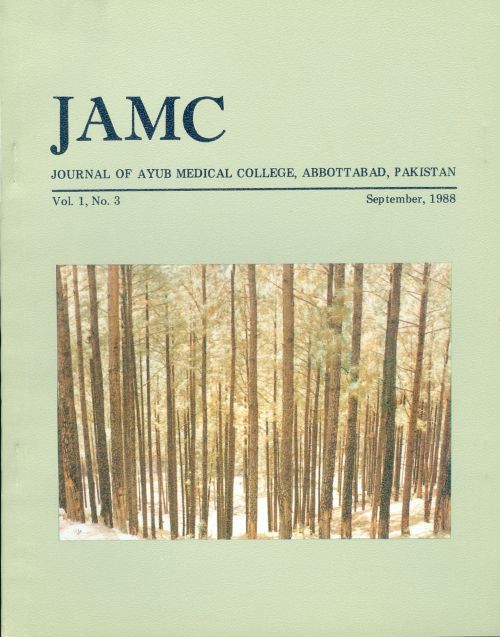INCIDENCE OF URINARY TRACT INFECTION DURING PREGNANCY
Abstract
Abstract: Incidence of Urinary tract infection was determined in 164 pregnant women presentedat DHQ Teaching Hospital, Abbottabad. The cases with significant bacteriuria (> 10 5organisms/ml of Urine) were 9.7% of total. 76% of the patients were less than 30 years of agewith mean of 28 years. In the symptomatic group the frequency of UTI was 12.5% while in theasymptomatic group it was about 4.0%. Pyuria was found in 13.4% of the total cases. Albuminand Glucose in Urine were found to be 6% and 3% respectively.The organisms isolated were E. Coli (56.3%) Staphylococcus (25.0%) Klebsiella Spp(12.5%) and proteus Spp (6.2%). Most of them were sensitive to Minocin, Gentamycin,Claforan, whereas the sensitivity to Amoxil, Dalacin, Fosfomycin and Doxycyclin was variable.References
Dontas, A.S., Kasviki-Charvati, P. and Papanayiotou, P.C. Bacteriuria and Survival in old age. M.
Engl. N. Med. 1981; 304: 939.
Evans. D.A., Kass, E.H. and Hennekens, C.H. Bacteriuria and subsequent mortality in women.
Lancet. 1982; 1:156.
Platt. R., Polk, B.F. and Murdock, B. Reduction of mortality associated with nosocomial urinary tract
infection. Lancet; 1983; 1:893.
Baker, F.J. Hand Book of Bacteriological Techniques. 2nd ed., Butter Worths & Company Ltd.,
London; 1967.
Free, A.H. and Free, H.M. Urinalysis, Critical Discipline of Clinical Science CRS Crit. Rev. Clin.
Lab. Sci., 3CW; 1972; 481:531.
Shank, C.R., Guguid, J.P. and Marmion, B.P. Medical Microbiological Vol. II, 12th ed., Churchill
Livingstone, London; 1975.
Davison, J.M., Sprott, M S. and Selkon, J.B. The effect of covert bacteriuria in school girls on renal
function at 18 years and during pregnancy. Lancet; 1984: ii, 651.
Khaliq, M.A., Khan J.A. and Shaheen, P.K. and Farida, A. Bacteriological study of Urinary tract
infections in healthy school going children of Hazara. Pak. J. Med. Res. 1986; 25: No. 1:27.
Issue
Section
License
Journal of Ayub Medical College, Abbottabad is an OPEN ACCESS JOURNAL which means that all content is FREELY available without charge to all users whether registered with the journal or not. The work published by J Ayub Med Coll Abbottabad is licensed and distributed under the creative commons License CC BY ND Attribution-NoDerivs. Material printed in this journal is OPEN to access, and are FREE for use in academic and research work with proper citation. J Ayub Med Coll Abbottabad accepts only original material for publication with the understanding that except for abstracts, no part of the data has been published or will be submitted for publication elsewhere before appearing in J Ayub Med Coll Abbottabad. The Editorial Board of J Ayub Med Coll Abbottabad makes every effort to ensure the accuracy and authenticity of material printed in J Ayub Med Coll Abbottabad. However, conclusions and statements expressed are views of the authors and do not reflect the opinion/policy of J Ayub Med Coll Abbottabad or the Editorial Board.
USERS are allowed to read, download, copy, distribute, print, search, or link to the full texts of the articles, or use them for any other lawful purpose, without asking prior permission from the publisher or the author. This is in accordance with the BOAI definition of open access.
AUTHORS retain the rights of free downloading/unlimited e-print of full text and sharing/disseminating the article without any restriction, by any means including twitter, scholarly collaboration networks such as ResearchGate, Academia.eu, and social media sites such as Twitter, LinkedIn, Google Scholar and any other professional or academic networking site.









